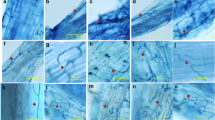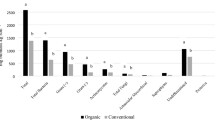Abstract
Selective isolation, molecular identification and AFLP were used to investigate the distribution of the various species of endophytic and epiphytic Trichoderma associated with banana roots and to compare and contrast their genetic structure. Three specific groups of Trichoderma were observed in the roots of banana. Group one, which made up the largest population, comprised T. asperellum, T. virens, and Hypocrea lixii, which were isolated from both inside and on the surface of the banana roots, while group two, made up of T. atroviride and T. koningiopsis, existed on the surface only. Group three, comprising only T. brevicompactum was isolated from the inside of the roots. The AFLP analysis revealed Nei’s diversity indices of 0.15 and 0.26 for epiphytic T. asperellum and T. virens, respectively. The index values of 0.11 and 0.11 were obtained for endophytic T. asperellum and T. virens, respectively. The genetic diversity within endophytic T. asperellum and T. virens was lower than that within the epiphytes. This suggests that endophytic Trichoderma has a higher genetic conservation and is compatible with the relatively stable microenvironments inside roots.



Similar content being viewed by others
References
Arnold AR (2007) Understanding the diversity of foliar endophytic fungi: progress, challenges, and frontiers. Fungal Biol Rev 21:51–66
Buntjer JB (1999) Cross checker fingerprint analysis software v2.9. Wageningen University and Research Centre, Wageningen
Buyer JS, Kaufman DD (1996) Microbial diversity in the rhizosphere of corn grown under conventional and low-input systems. Appl Soil Ecol 5:21–27
Chaverri P, Castlebury LA (2003) Hypocrea/Trichoderma: species with conidiophore elongations and green conidia. Mycologia 95:1100–1140
Chen WD, Hoitink HAJ, Schmitthenner AF (1988) The role of microbial activity in suppression of damping-off caused by Pythium ultimum. Phytopathology 78:314–322
Druzhinina I, Kopchinskiy AG, Komon M, Bissett J, Szakács G, Kubicek CP (2005) An oligonucleotide barcode for species identification in Trichoderma and Hypocrea. Fungal Genet Biol 42:813–828
Elad Y, Chet I (1983) Improved selective media for isolation of Trichoderma spp. or Fusarium spp. Phytoparasitica 11:55–58
Girlanda M, Perotto S, Moenne-Loccoz Y, Bergero R, Lazzari A, Defago G, Bonfante P, Luppi AM (2001) Impact of biocontrol Pseudomonas fluorescens CHA0 and a genetically modified derivative on the diversity of culturable fungi in the cucumber rhizosphere. App Environ Microbiol 67:1851–1864
Harman GE, Howell CR, Viterbo A, Chet I, Lorito M (2004) Trichoderma species-opportunistic, avirulent plant symbionts. Nat Rev 2:43–56
Hoyos-Carvajal L, Orduz S, Bissett J (2009) Genetic and metabolic biodiversity of Trichoderma from Colombia and adjacent neotropic regions. Fungal Genet Biol 46:615–631
Jaklitsch WM, Komon M, Kubicek CP (2006) Hypocrea crystalligena sp. nov., a common European species with a white-spored Trichoderma anamorph. Mycologia 98:499–514
Kimura M (1980) A simple method for estimating evolutionary rates of base substitutions through compararative studies of nucleotide sequences. J Mol Evol 16: 111–120
Kopchinskiy A, Komon M, Kubicek CP, Druzhinina IS (2005) TrichoBLAST: a multilocus database for Trichoderma and Hypocrea identifications. Mycol Res 109:657–660
Krause A, Ramakumar A, Bartels D, Battistoni F, Bekel T, Reinhold-Hurek B (2006) Complete genome of the mutualistic, N2-fixing grass endophyte Azoarcus sp. strain BH72. Nat Biotechnol 24:1385–1391
Kullnig-Gradinger CM, Szakacsm G, Kubicek CP (2002) Phylogeny and evolution of the genus Trichoderma: a multigene approach. Mycol Res 106:757–767
Legault D, Dessureault M, Laflamme G (1989) Mycoflora of Pinus banksiana and Pinus resinosa needles. I. Endophytic fungi. Can J Bot 67:2052–2060
Legault D, Dessureault M, Laflamme G (1989) Mycoflora of Pinus banksiana and Pinus resinosa needles. II. Epiphytic fungi. Can J Bot 67:2061–2065
Minamisawa K (2006) A milestone for endophyte biotechnology. Nat Biotechnol 24:1357–1358
Nel B, Steinberg C, Labuschagne N, Viljoen A (2006) The potential of nonpathogenic Fusarium oxysporum and other biological control organisms for suppressing fusarium wilt of banana. Plant Pathol 55:217–223
Photita W, Lumyong S, Lumyong P, Hyde K (2001) Endophytic fungi of wild banana (Musa acuminate) at Doi Suthep Pui national park, Thailand. Mycol Res 105:1508–1513
Pocasangre L, Sikora RA, Vilich V, Schuster RP (2000) Survey of banana endophytic fungi from Central America and screening for biological control of the burrowing nematode (Radopholus similis). InfoMusa 9:3–5
Rohlf FJ (1994) NTSYS-PC: Numerical Taxonomy and Multivariate Analysis Syst, Version 1.80. Exeter Software, New York
Samuels GJ, Chaverri P, Farr DF, McCray EB (2010) Trichoderma Online, Systematic Mycology and Microbiology Laboratory, ARS, USDA. Retrieved October 19, 2010, from http://nt.ars-grin.gov/taxadescriptions/keys/TrichodermaIndex.cfm
Santamaría J, Bayman P (2005) Fungal epiphytes and endophytes of coffee leaves (Coffea arabica). Microb Ecol 50:1–8
Sikora RA, Pocasangre L, Felde AZ, Niere B, Vu TT, Dababat AA (2008) Mutualistic endophytic fungi and in-planta suppressiveness to plant parasitic nematodes. Biol Control 46:15–23
Tamura K, Dudley J, Nei M, Kumar S (2007) MEGA4: molecular evolutionary genetics analysis (MEGA) software version 4.0. Mol Biol Evol 24:1596–1599
Thompson JD, Gibson TJ, Plewniak F, Jeanmougin F, Higgins DG (1997) The ClustalX windows interface: flexible strategies for multiple sequence alignment aided by quality analysis tools. Nucleic Acids Res 24:4876–4882
Vos P, Hogers R, Bleeker M, Reijans M (1995) AFLP: a new technique for DNA fingerprinting. Nucleic Acids Res 23:4407–4414
Widden P, Abitbol JJ (1980) Seasonality of Trichoderma species in a spruce-forest soil. Mycologia 72:775–784
Wuczkowski M, Druzhinina I, Gherbawy Y, Klug K, Prillinger HJ, Kubicek CP (2003) Species pattern and genetic diversity of Trichoderma in a mid-European, primeval floodplain-forest. Microbiol Res 158:125–133
Yang HT, Ryder M, Tang WH (2005) Toxicity of fungicides and selective medium development for isolation and enumeration of Trichoderma spp. in agricultural soils. Shandong Sci 18:113–122 (in English)
Yeh FC, Yang R, Boyle TJ, Ye Z, Xiyan JM (2000) POPGENE 3.2: Microsoft windows-based freeware for population genetic analysis. Molecular Biology and Biotechnology Centre, University of Alberta, Edmonton
Zhang CL, Druzhinina S, Kubicek CP, Xu T (2005) Trichoderma biodiversity in China: evidence for a north to south distribution of species in East Asia. FEMS Microbiol Lett 251:251–257
Zhang CL, Liu SP, Lin FC, Kubicek CP, Druzhinina LS (2007) Trichoderma taxi sp.nov., an endophytic fungus from Chinese yew Taxus mairei. FEMS Microbiol Lett 270:90–96
Zum Felde A (2002) Screening of endophytic fungi from banana (Musa) for antagonistic effects towards the burrowing nematode Radopholus similis (Cobb) Thorne. M.Sc. Thesis, University of Bonn, Germany
Zum Felde A, Pocasangre L, Sikora RA (2005) The potential use of microbial communities inside suppressive banana plants for banana root protection. In: Turner DW, Rosales FE (ed) Banana root system: Towards a better understanding for its productive management, proceedings of an international symposium held in San Jośe. Costa Rica, 3–5 November, 2003, pp 169–177
Acknowledgments
We are grateful for the support of National Natural Sciences Foundation of China (30500632), National High Technology Research and Development Program of China (2006AA10A02), and project (F) 2007DFA30970 of the Ministry of Science and Technology.
Author information
Authors and Affiliations
Corresponding author
Electronic Supplementary Material
Below is the link to the electronic supplementary material.
Table S1
The identification of Trichoderma isolated from banana roots and their accession numbers in GenBank (PDF 48 kb)
Table S2
Genetic identity within endophytic T. virens and epiphytic T. virens (PDF 74 kb)
Table S3
Genetic identity within endophytic T. asperellum and epiphytic T. asperellum (PDF 17 kb)
Rights and permissions
About this article
Cite this article
Xia, X., Lie, T.K., Qian, X. et al. Species Diversity, Distribution, and Genetic Structure of Endophytic and Epiphytic Trichoderma Associated with Banana Roots. Microb Ecol 61, 619–625 (2011). https://doi.org/10.1007/s00248-010-9770-y
Received:
Accepted:
Published:
Issue Date:
DOI: https://doi.org/10.1007/s00248-010-9770-y




